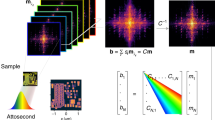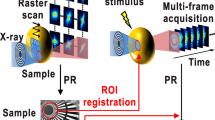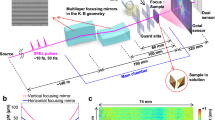Abstract
Coherent Diffractive Imaging (CDI) is an algorithmic imaging technique where intricate features are reconstructed from measurements of the freely diffracting intensity pattern. An important goal of such lensless imaging methods is to study the structure of molecules that cannot be crystallized. Ideally, one would want to perform CDI at the highest achievable spatial resolution and in a single-shot measurement such that it could be applied to imaging of ultrafast events. However, the resolution of current CDI techniques is limited by the diffraction limit, hence they cannot resolve features smaller than one half the wavelength of the illuminating light. Here, we present sparsity-based single-shot subwavelength resolution CDI: algorithmic reconstruction of subwavelength features from far-field intensity patterns, at a resolution several times better than the diffraction limit. This work paves the way for subwavelength CDI at ultrafast rates, and it can considerably improve the CDI resolution with X-ray free-electron lasers and high harmonics.
This is a preview of subscription content, access via your institution
Access options
Subscribe to this journal
Receive 12 print issues and online access
$259.00 per year
only $21.58 per issue
Buy this article
- Purchase on Springer Link
- Instant access to full article PDF
Prices may be subject to local taxes which are calculated during checkout



Similar content being viewed by others
References
Abbe, E. Beiträge zur Theorie des Mikroskops und der Mikroskopischen Wahrnehmung. Arch. Mikrosk. Anatomie 9, 413–468 (1873).
Lipson, S. G., Lipson, H. & Tannhauser, D. S. Optical Physics 3rd edn (Cambridge Univ. Press, 1995).
Lewis, A., Isaacson, M., Harotunian, A. & Muray, A. Development of a 500- Å spatial-resolution light-microscope: I. Light is efficiently transmitted through λ/16 diameter apertures. Ultramicroscopy 13, 227–231 (1984).
Betzig, E., Trautman, J. K., Harris, T. D., Weiner, J. S. & Kostelak, R. L. Breaking the diffraction barrier: Optical microscopy on a nanometric scale. Science 251, 1468–1470 (1991).
Di Francia, G. T. Super-gain antennas and optical resolving power. Nuovo Cimento 9, 426–438 (1955).
Lezec, H. J. et al. Beaming light from a subwavelength aperture. Science 297, 820–823 (2002).
Huang, F. M. & Zheludev, N. I. Super-resolution without evanescent waves. Nano Lett. 9, 1249–1254 (2009).
Hell, S. W. & Wichmann, J. Breaking the diffraction resolution limit by stimulated emission: Stimulated-emission-depletion microscopy. Opt. Lett. 19, 780–783 (1994).
Yildiz, A. et al. Myosin V walks hand-overhand: Single fluorophore imaging with 1.5 nm localization. Science 300, 2061–2065 (2003).
Hell, S. W., Schmidt, R. & Egner, A. Diffraction-unlimited three-dimensional optical nanoscopy with opposing lenses. Nature Photon. 3, 381–387 (2009).
Harris, J. L. Diffraction and resolving power. J. Opt. Soc. Am. 54, 931–936 (1964).
Papoulis, A. A new algorithm in spectral analysis and band-limited extrapolation. IEEE Trans. Circuits Syst. 22, 735–742 (1975).
Gerchberg, R. W. Super-resolution through error energy reduction. J. Mod. Opt. 21, 709–720 (1974).
Goodman, J. W. Introduction to Fourier Optics 3rd edn (Roberts, 2005).
Gazit, S., Szameit, A., Eldar, Y. C. & Segev, M. Super-resolution and reconstruction of sparse subwavelength images. Opt. Exp. 17, 23920–23946 (2009).
Candes, E. J., Romberg, J. & Tao, T. Robust uncertainty principles: Exact signal reconstruction from highly incomplete frequency information. IEEE Trans. Inf. Theory 52, 489–509 (2006).
Donoho, D. L. Compressed sensing. IEEE Trans. Inf. Theory 52, 1289–1306 (2006).
Candes, E. J. & Tao, T. Near-optimal signal recovery from random projections: Universal encoding strategies? IEEE Trans. Inf. Theory 52, 5406–5425 (2006).
Candes, E. J. & Wakin, M. B. An introduction to compressive sampling. IEEE Signal Process. Mag. 25, 21–30 (2008).
Duarte, M. & Eldar, Y. C. Structured compressed sensing: From theory to applications. Trans. Signal Process. 59, 4053–4085 (2011).
Szameit, A. et al. Far-field microscopy of sparse subwavelength objects, Preprint at http://arxiv.org/abs/1010.0631v1 (2010).
Shechtman, Y., Gazit, S., Szameit, A., Eldar, Y. C. & Segev, M. Super-resolution and reconstruction of sparse images carried by incoherent light. Opt. Lett. 35, 1148–1150 (2010).
Shechtman, Y., Eldar, Y. C., Szameit, A. & Segev, M. Sparsity-based subwavelength imaging with partially spatially incoherent light via quadratic compressed sensing. Opt. Exp. 19, 14807–14822 (2011).
Derin, S. D., Wang, Z., Do, M. & Popescu, G. Cell imaging beyond the diffraction limit using sparse deconvolution spatial light interference microscopy. Biomedical Opt. Exp. 2, 1815–1827 (2011).
Sayre, D. Some implications of a theorem due to Shannon. Acta Crystallogr. 5, 843 (1952).
Miao, J., Charalambous, P., Kirz, J. & Sayre, D. Extending the methodology of X-ray crystallography to allow imaging of micrometer-sized non-crystalline specimens. Nature 400, 342–344 (1999).
Quiney, H. M. Coherent diffractive imaging using short wavelength light sources: A tutorial review. J. Mod. Opt. 57, 1109–1149 (2010).
Chapman, H. N. & Nugent, K. A. Coherent lensless X-ray imaging. Nature Photon. 4, 833–839 (2010).
Sandberg, R. L. et al. Lensless diffractive imaging using tabletop coherent high-harmonic soft-X-ray beams. Phys. Rev. Lett. 99, 098103 (2007).
Chapman, H. N. et al. Femtosecond time-delay X-ray holography. Nature 448, 676–679 (2007).
Neutze, R., Wouts, R., van der Spoel, D., Weckert, E. & Hajdu, J. Potential for biomolecular imaging with femtosecond X-ray pulses. Nature 406, 752–757 (2000).
Chapman, H. M. et al. Femtosecond X-ray protein nanocrystallography. Nature 470, 73–77 (2011).
Vetterli, M., Marziliano, P. & Blu, T. Sampling signals with finite rate of innovation. IEEE Trans. Signal Process. 50, 1417–1428 (2002).
Gleichman, S. & Eldar, Y. C. Blind compressed sensing. IEEE Trans. Inform. Theory 57, 6958–6975 (2011).
Aharon, M., Elad, M. & Bruckstein, A. K-SVD: An algorithm for designing overcomplete dictionaries for sparse representation. IEEE Trans. Signal Process. 54, 4311–4322 (2006).
Sidorenko, P. et al. The 2010 Frontiers Optics Conference, OSA Technical Digest (Optical Society of America, 2010), Paper FTuE2.
Acknowledgements
This work was partially supported by an Advanced Grant from the European Research Council. A.S. thanks the Leopoldina—the German Academy of Natural Sciences for financial support (grant LPDS 2009-13). The research of O.C., E.B. and P.S. was supported by the Legacy Heritage Science Initiative Program (‘MORASHA’) of the Israel Science Foundation.
Author information
Authors and Affiliations
Contributions
All authors contributed significantly to the work presented in this paper.
Corresponding author
Ethics declarations
Competing interests
The authors declare no competing financial interests.
Supplementary information
Supplementary Information
Supplementary Information (PDF 907 kb)
Rights and permissions
About this article
Cite this article
Szameit, A., Shechtman, Y., Osherovich, E. et al. Sparsity-based single-shot subwavelength coherent diffractive imaging. Nature Mater 11, 455–459 (2012). https://doi.org/10.1038/nmat3289
Received:
Accepted:
Published:
Issue Date:
DOI: https://doi.org/10.1038/nmat3289
This article is cited by
-
Non-interferometric stand-alone single-shot holographic camera using reciprocal diffractive imaging
Nature Communications (2023)
-
AutoPhaseNN: unsupervised physics-aware deep learning of 3D nanoscale Bragg coherent diffraction imaging
npj Computational Materials (2022)
-
Sparse deconvolution improves the resolution of live-cell super-resolution fluorescence microscopy
Nature Biotechnology (2022)
-
Spectral super-resolution spectroscopy using a random laser
Nature Photonics (2020)
-
Recent advances in point spread function engineering and related computational microscopy approaches: from one viewpoint
Biophysical Reviews (2020)



